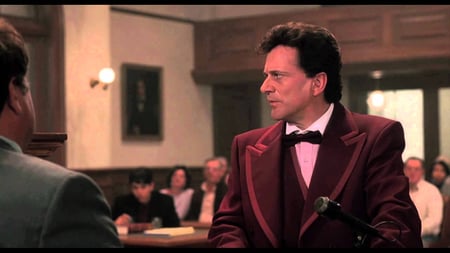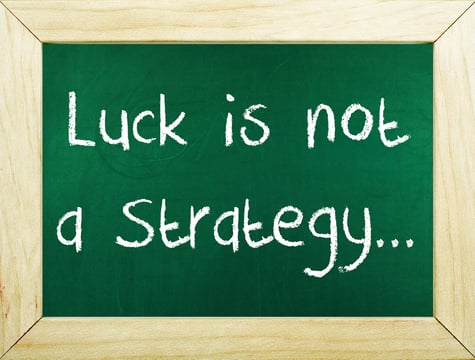 Over the holiday break, I had a chance to relax and watch some of my favorite old movies. One of those was the classic (can we call it that?) My Cousin Vinny. I love the movie on several levels. One of my favorite scenes is when Joe Pesci questions his first witness about grits. To prove the witness had his timeline wrong, he asks if the witness has magic grits, that violate the laws of physics.
Over the holiday break, I had a chance to relax and watch some of my favorite old movies. One of those was the classic (can we call it that?) My Cousin Vinny. I love the movie on several levels. One of my favorite scenes is when Joe Pesci questions his first witness about grits. To prove the witness had his timeline wrong, he asks if the witness has magic grits, that violate the laws of physics.
I think I like the scene so much because it reminds me of so many conversations I have with entrepreneurs, sales executives and other growth-oriented individuals. People regularly come to me to share their growth goals and objectives. Invariably, I’m impressed by what they want to accomplish. I’m excited by their passion and their conviction that they’re doing something totally different and worth doing.
Then we begin to talk about what they’re willing to do to make it happen. Specifically I talk about their plan to attract, convert, close and delight customers. In an instant, they become different people. The seriousness, passion and confidence disappears and I quickly feel like I’m talking to someone about, well, magic grits.
The words are invariably different, but the tune is always the same.
- I want to start small and see how it progresses
- Well, we’ve got a really tight budget, but once we see results, we’ll definitely add to it.
- Let’s throw a couple things out there and then if we like what we see, we’ll really commit to it.
- Let’s blog for 3 months and see what it does to our traffic and leads, then we’ll decide if we stick to it.
Don’t get me wrong, I completely understand the importance of mitigating risk and living with restricted resource. I’ve started and run four businesses and I’ve never done anything without bootstrapping. To this day, I dream of investors offering to give me millions of dollars before I’ve built my product/service and developed a profitable revenue stream. I’ve often said that the most common and important decisions I make on a regularly basis are about what the company is not going to do.
Making the decision to do something new or change an approach is always tough, and I have tremendous empathy for those people that have to make those decisions. Not only do their families depend on how those decisions turn out, but the families of everyone involved in the organization are impacted as well.
 That said, (unless you have magic grits) if you want to talk seriously about growing the business, you must be equally serious about the commitment and risk (yes, risk) that you’re going to take. If I’ve learned one thing about risk in business decisions, it’s that the riskiest decision of all is paring down your efforts or investments.
That said, (unless you have magic grits) if you want to talk seriously about growing the business, you must be equally serious about the commitment and risk (yes, risk) that you’re going to take. If I’ve learned one thing about risk in business decisions, it’s that the riskiest decision of all is paring down your efforts or investments.
Let me share an example to highlight what I mean.
We are launching a new podcast series at the end of this month (much more to come on this). The decision required that we think through what would really be involved to make this happen and to give it the best chance of making it work.
We decided that if we were going to do it, we had to have a plan to create at least 40 podcasts this year. It’s a significant commitment. We’ve got to plan the shows, get the guests, conduct interviews, edit recordings, produce the show and promote it. This on top of already committing to increasing our blogging frequency from 3x/week to 4x.
As I was discussing this with Stacy, she reasonably asked if we had the resources available to make it happen, wouldn’t we be better off with a more modest goal of say 20 podcasts this year. As we considered our options, we came to this conclusion. While we have reason to believe that podcasting will contribute to our growth, we won’t know until we do it. We also realized that we were going to make mistakes and would learn from them.
Therefore committing to 40 podcasts was actually less risky than committing to 20. If we produced 20 episodes and didn’t see meaningful traction, we wouldn’t be able to draw any conclusions. There wouldn’t be enough data to determine the cause, nor the frequency to make adjustments. By doing 40, we’ll have data to draw at least some initial conclusions. We’re confident of this because we’ve built the platform and have an audience to give us a jumpstart.
The 12 to 18 Month Rule
When I first got involved in advising companies in the early 1990s, I would regularly caution our soon to be clients that it takes 12 to 18 months before any new effort to grow your market can be fully judged. While today’s more sophisticated approaches give you greater data and insights so you can make adjustments earlier, it still takes 12 to 18 months to get to the beginning of full impact.
I can’t help but laugh when someone tells me that they posted 18 blogs over five months and didn’t see the needle move. Really? No kidding. How about posting 100 blogs over 52 weeks and then tell me how it worked. Actually I don’t laugh, I cry a bit.
I regularly talk with companies about sales development and outbound efforts to stimulate results. They ask if they can run a test program for three months before making any long term decisions. I tell them sure they can, if they like throwing money away. What valuable decisions can you make when starting a brand new initiative in 3 months?
There are a couple of ways you can view the 12 to 18 month rule. On one hand you could say something like, “12 - 18 months...I can’t wait that long to see results, I need to see results right away!”
Or, you could say, “12 - 18 months, wow that’s a bit of a bummer. I wish we could get there sooner. But, you know what? I’m still going tobe here in 18 months, so I guess I’ve got to decide if I want 18 months from now to be a lot better than today, or if I want to be dealing with the same problems and frustrations then as I’m dealing with today.”
Eliminate The Excuses That Sabotage Your Growth
There are three excuses that kill your opportunities:
- I/we don’t have the patience. I call this the Veruca Salt syndrome - I want revenue growth and I want it now. This is simply an excuse and get rid of it. To mitigate risk and enhance the probability of success, be sure to set clear metrics so that you learn quickly and adjust.
- I/we don’t have the time. Implementing an effective lead generation and sales effort requires that a lot gets done. Writing blog posts is very time consuming and it takes a commitment. However, you don’t need to do these things by yourself. The time excuse is just a money excuse. Which brings me to …
- I/we don’t have the money. There are two versions of this excuse. For those that truly don’t have the money to invest, change the goal and use the money you do have to focus your efforts more specifically. Recognize that progress will be slower and bumpier.The second version of “we don’t have the money” really means “we don’t value the process,” which brings us back to our magic grits.
If The Result Is Worth It…
 I’m overweight. I really wish I wasn’t. But how smart would I be if I went on diet for three months and then blamed the diet for not losing 100 pounds of fat and gaining 30 pounds of muscle? It’s silly to even think about it, but I regularly see smart company executives act just this way when it comes to lead generation, marketing and sales initiatives.
I’m overweight. I really wish I wasn’t. But how smart would I be if I went on diet for three months and then blamed the diet for not losing 100 pounds of fat and gaining 30 pounds of muscle? It’s silly to even think about it, but I regularly see smart company executives act just this way when it comes to lead generation, marketing and sales initiatives.
And please note, I’m not talking about small businesses with a couple of employees. I’m talking about executives of companies doing $5 to $50 million in revenue with tens to even hundreds of employees. They acknowledge the world has changed, that their current approaches are no longer as effective as they need to be and they’re serious about accelerating their growth. But when it comes time to decide what they’re willing to invest and what they’re willing to change, they become timid.
I remember when I started Imagine. I was a very successful financial advisor with Merrill Lynch. I was making great money and set up a system that enabled me to make that money without having to work particularly hard. From the outside, it looked as though I had it made.
The problem for me was that I knew much of what was happening was a mirage. I owned nothing (in terms of intellectual property), the world was changing dramatically, and the company I worked for was not doing what I thought needed to be done (turned out I was more on point with that observation than I could have imagined). So I left to start my own company.
Soon after leaving I met with one of my clients to bring them to my new firm. She was happy to see me and I’ll never forget what she said, “Wow Doug, that’s really risky what you’re doing. I don’t think I could have ever done that.” I responded, “Actually Anne, it’s the least risky thing I could do. By leaving I can make sure things are being done as they should be, and I’m not relying on the tide to bring me home.”
When crafting your growth strategy, remember that fully committing to your desired outcomes is far less risky than only going half way.

 Doug Davidoff
Doug Davidoff